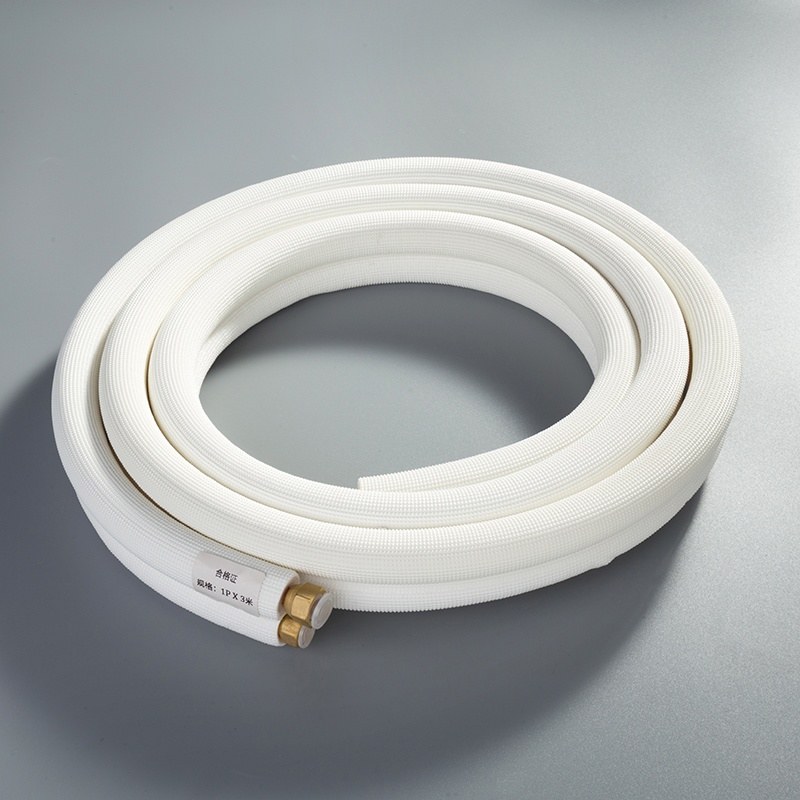How to Braze Copper Pipes for Air Conditioner Efficiency

Brazing is essential in HVAC systems, particularly for air conditioner copper pipe welding. It ensures strong and durable connections, which are vital for efficiency and reliability. A properly brazed joint is almost leak-proof, reducing concerns about air conditioner copper pipe leaks. Selecting the appropriate braze alloy is crucial to prevent failures. By mastering brazing techniques, you improve the performance and extend the lifespan of your air conditioning system. This not only saves money but also maintains a comfortable environment, even when the air conditioner copper pipe gets hot.
Preparation Steps
Before you dive into the brazing process, it's crucial to prepare properly. This ensures that your air conditioner copper pipe welding is efficient and effective. Let's break down the steps you need to follow.
Cleaning Copper Surfaces
A clean surface is essential for a strong bond. Dirt or oxidation can weaken the joint, leading to potential leaks.
Tools and Materials Needed
To get started, gather the following tools and materials:
Wire Brush: Use this to scrub away any surface grime.
Emery Cloth: This helps in smoothing out the copper surface.
Acetone or Alcohol: These solvents remove oils and residues.
Clean Cloth: For wiping down the surfaces after cleaning.
Techniques for Effective Cleaning
Scrub the Surface: Use the wire brush to remove any visible dirt or oxidation. Make sure you cover all areas that will be joined.
Smooth with Emery Cloth: Rub the emery cloth over the copper to ensure a smooth surface. This step helps the brazing material adhere better.
Wipe with Solvent: Dampen a clean cloth with acetone or alcohol and wipe the copper. This removes any remaining oils or residues.
Dry Thoroughly: Ensure the copper is completely dry before proceeding to the next step.
Selecting Brazing Rods
Choosing the right brazing rod is vital for a successful weld. The rod's composition affects the strength and durability of the joint.
Understanding Silver Content
Brazing rods come with varying silver content, which impacts their performance:
0% Silver: Suitable for basic applications but offers less ductility.
5% Silver: Provides moderate strength and flexibility.
15% Silver: Offers high strength and excellent ductility, ideal for critical joints.
Choosing the Right Rod for the Job
Consider the following when selecting your brazing rod:
Application Needs: For air conditioner copper pipe welding, a rod with higher silver content is often preferred due to its strength and flexibility.
Temperature Requirements: Ensure the rod matches the brazing temperature range, typically between 1,150°F and 1,550°F. Silver-based rods work well at the lower end of this spectrum.
Pipe Size: Larger pipes may require rods with higher silver content to ensure a robust joint.
By following these preparation steps, you set the stage for a successful brazing process. Proper cleaning and the right choice of brazing rods are key to achieving durable and efficient air conditioner copper pipe welding.
The Brazing Process

Now that you've prepared your copper pipes, it's time to move on to the brazing process. This step is crucial for creating a strong and reliable joint. Let's dive into the details.
Heating the Copper
Heating the copper correctly is essential for a successful brazing process. You need to reach the right temperature to ensure the filler metal flows and bonds properly.
Required Temperature Levels
For brazing copper, you should aim for temperatures between 1,200°F and 1,500°F. This range allows the silver filler metals to melt and create a strong joint. It's important to monitor the temperature closely to avoid overheating, which can damage the copper.
Tools for Heating
To achieve the necessary temperature, you'll need the right tools:
Torch: A propane or oxy-acetylene torch works well for heating copper pipes.
Temperature Indicator: Use a temperature crayon or infrared thermometer to ensure you're within the optimal range.
Heat Shield: Protect nearby surfaces from the intense heat with a heat shield or fire-resistant cloth.
Using Nitrogen
Incorporating nitrogen into the brazing process can significantly improve the quality of your joints. It helps prevent oxidation, which can weaken the connection.
Purpose of Nitrogen in Brazing
Nitrogen acts as a protective gas during brazing. It displaces oxygen inside the pipes, preventing oxidation and the formation of flaky deposits. These deposits can obstruct refrigerant flow, reducing the efficiency of your air conditioning system.
How to Apply Nitrogen Correctly
Follow these steps to use nitrogen effectively:
Connect the Nitrogen Tank: Attach a regulator to the nitrogen tank and connect it to the pipe system.
Purge the System: Before brazing, purge the pipes with nitrogen to remove any oxygen.
Maintain a Steady Flow: Keep a low, steady flow of nitrogen throughout the brazing process. This ensures continuous protection against oxidation.
Monitor Pressure: Use a pressure gauge to maintain the correct nitrogen flow rate, typically around 2-3 psi.
By following these steps, you can ensure a successful brazing process. Proper heating and the use of nitrogen will help you create strong, durable joints that enhance the efficiency of your air conditioning system.
Common Challenges and Solutions
When brazing copper pipes for air conditioners, you might encounter some common challenges. Understanding these issues and knowing how to address them can make your work more efficient and effective.
Avoiding the Use of Flux
Why Flux is Not Recommended
In many brazing processes, flux plays a crucial role. It prevents oxide formation and helps the filler metal bond to surfaces. However, in HVAC systems, using flux is not recommended. Flux can lead to contamination inside the pipes, which might cause an air conditioner copper pipe leak. Manufacturers often advise against using flux to maintain the integrity of the system.
Alternatives to Flux
You might wonder how to proceed without flux. Here are some alternatives:
Use of Nitrogen: As mentioned earlier, nitrogen can prevent oxidation during brazing. It acts as a protective shield, ensuring the copper remains clean and free from oxides.
Proper Cleaning: Thoroughly clean the copper surfaces before brazing. This reduces the need for flux by ensuring a clean bonding surface.
Controlled Environment: Work in a controlled environment where you can manage the exposure to air, reducing the risk of oxidation.
Ensuring Proper Technique
Mastering the right technique is essential to avoid issues like air conditioner copper pipe leaks. Let's look at some key aspects.
Preventing Oxidation
Oxidation can weaken your joints and lead to leaks. To prevent this:
Use Nitrogen: As previously discussed, nitrogen displaces oxygen, preventing oxidation.
Quick Work: Minimize the time the copper is exposed to air. Prepare everything in advance so you can work swiftly.
Maintaining Consistent Heat
Consistent heat application is vital for a strong joint. Here's how you can achieve it:
Even Heating: Move the torch evenly around the joint. This ensures uniform heat distribution, preventing weak spots.
Temperature Monitoring: Use tools like infrared thermometers to keep track of the temperature. Staying within the optimal range prevents overheating or underheating, both of which can compromise the joint.
By addressing these challenges with the right solutions, you can enhance the efficiency and reliability of your air conditioning system. Proper technique and careful attention to detail will help you avoid common pitfalls, ensuring your system runs smoothly without the risk of an air conditioner copper pipe leak.
Safety Considerations

When brazing copper pipes, safety should always be your top priority. Let's explore the essential safety measures you need to take.
Personal Protective Equipment
Wearing the right gear can protect you from potential hazards during brazing.
Essential Safety Gear
You should equip yourself with the following safety gear:
Safety Glasses: Protect your eyes from sparks and intense light.
Heat-Resistant Gloves: Shield your hands from burns.
Welding Jacket: Wear a flame-resistant jacket to protect your skin.
Respirator Mask: Use a mask to avoid inhaling harmful fumes.
Lucas Milhaupt Expert emphasizes the importance of safety equipment, stating that "arc rays and sparks can result in loss of sight, fume inhalation can lead to lung damage, and other accidents can cause burns, fires, or explosions."
Safe Handling of Tools
Handling tools safely is crucial to prevent accidents. Here are some tips:
Inspect Tools: Check your torch and other equipment for any damage before use.
Secure Connections: Ensure all connections are tight to prevent gas leaks.
Proper Storage: Store your tools in a safe, dry place when not in use.
Working Environment
Creating a safe working environment is just as important as wearing the right gear.
Ventilation Requirements
Good ventilation is essential to disperse fumes and maintain air quality.
Open Windows and Doors: Allow fresh air to circulate in your workspace.
Use Exhaust Fans: Install fans to remove fumes and smoke.
Avoid Confined Spaces: Work in open areas whenever possible.
NTT Inc. Expert highlights that brazers are exposed to fumes, which can be hazardous if not properly managed. Proper training and practice can help control the temperature and ensure safe working conditions.
Fire Safety Precautions
Fire safety is critical when working with high temperatures.
Keep a Fire Extinguisher Nearby: Always have an extinguisher within reach.
Clear Flammable Materials: Remove any flammable items from your workspace.
Monitor Heat Sources: Keep an eye on your torch and other heat sources to prevent accidental fires.
By following these safety considerations, you can ensure a secure and efficient brazing process. Remember, taking the time to prepare and protect yourself is always worth it.
Maintenance and Inspection
Keeping your air conditioning system in top shape involves regular maintenance and inspection of the brazed joints. This ensures that your system runs efficiently and prevents issues like leaks or reduced performance. Let's explore how you can maintain and inspect these crucial components.
Regular Inspection of Joints
Regularly inspecting the joints in your air conditioning system is essential. It helps you catch any potential problems early, ensuring that your system remains efficient and reliable.
Signs of Wear and Tear
When inspecting your brazed joints, look for signs of wear and tear. These might include:
Discoloration: A change in color can indicate overheating or oxidation.
Cracks or Fractures: Visible cracks suggest that the joint may fail soon.
Leaks: Any sign of leakage around the joint is a red flag.
Tip: Incorporate inspection procedures into your routine. Use both nondestructive and destructive methods based on your system's requirements. This approach helps you identify issues without causing further damage.
When to Re-braze
Knowing when to re-braze is crucial for maintaining your system's efficiency. Consider re-brazing if you notice:
Significant Wear: If the joint shows extensive wear, it's time to re-braze.
Persistent Leaks: If leaks persist despite minor repairs, re-brazing may be necessary.
Structural Damage: Any structural damage to the joint requires immediate attention.
Note: Subjecting a brazed joint to a one-time load greater than the service level can help test its integrity. Methods like hydrostatic testing or tensile loading can be useful.
Maintaining Air Conditioner Efficiency
Routine maintenance plays a vital role in keeping your air conditioner running smoothly. It ensures that your system remains efficient, even when the air conditioner copper pipe gets hot. Routine maintenance
Routine Maintenance Tips
Here are some tips to help you maintain your air conditioning system:
Clean Filters Regularly: Dirty filters can reduce efficiency. Clean or replace them every few months.
Check Refrigerant Levels: Low refrigerant levels can cause the air conditioner copper pipe to get hot. Ensure levels are adequate.
Inspect Coils: Dirty coils can lead to overheating. Clean them to maintain optimal performance.
Advice: Regular maintenance not only improves efficiency but also extends the lifespan of your system. It helps prevent issues like the air conditioner copper pipe getting hot unnecessarily.
Long-term Benefits of Proper Brazing
Proper brazing techniques offer long-term benefits for your air conditioning system:
Enhanced Durability: Strong joints withstand high pressures, reducing the risk of leaks.
Improved Efficiency: Well-brazed joints ensure smooth refrigerant flow, keeping your system efficient.
Cost Savings: By preventing leaks and maintaining efficiency, you save on energy bills and repair costs.
By following these maintenance and inspection tips, you can ensure that your air conditioning system remains efficient and reliable. Regular checks and proper brazing techniques will help you avoid common issues, keeping your system running smoothly even when the air conditioner copper pipe gets hot.
You've learned the essentials of brazing copper pipes for air conditioner efficiency. Proper preparation, heating, and the use of nitrogen are key steps. These techniques ensure strong, reliable joints that withstand high pressures and temperatures. Remember, mastering these skills not only enhances your system's performance but also extends its lifespan. So, take what you've learned and apply it. You'll enjoy a more efficient air conditioning system and save on energy costs. Keep practicing, and soon, you'll be brazing like a pro!
See Also
Enhance Air Conditioner Performance with Copper Piping Secrets
The Importance of Pure Copper Piping in Air Conditioning
Transforming Air Conditioning with Pure Copper Piping
Benefits of Selecting Copper Piping for Air Conditioning
Key Factors in the Copper Piping Revolution for Air Conditioning


